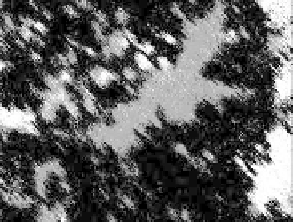Geoscience Reference
In-Depth Information
(a)
(b)
400
400
1
1
350
350
300
300
250
250
200
200
0.5
0.5
150
150
100
100
50
50
0
0
50
100
150
200
250
300
350
400
450
500
50
100
150
200
250
300
350
400
450
500
(c)
(d)
400
400
1
350
350
300
300
Rangeland
250
250
200
200
0.5
Shrub
150
150
100
100
Forest
50
50
0
50
100
150
200
250
300
350
400
450
500
50
100
150
200
250
300
350
400
450
500
Overall accuracy=79.75% , Kappa=59.26%
Figure 11.4
Conditional probabilities for forest (a), shrub (b), and rangeland (c), based on Bayesian integration
of spectrally derived and spacially derived preposterior probabilities (GML/OIK), and corresponding
MAP selection (d).
0.59, a 9.6% and 34.1% improvement, respectively, relative to the corresponding accuracy statistics
computed from the GML classification.
For comparison, accuracy assessment statistics, including producer's and user's accuracy, for
all classification algorithms considered in this chapter are tabulated in Table 11.2. Clearly, classi-
fication accuracy using the proposed contextual classification methods was superior to that using
only spectral or only spatial information. As stated above, overall accuracy and the Kappa coeffi-
cients are significantly higher for the proposed methods. In addition, both producer's and user's
accuracy for all three classes are higher than the corresponding values computed from the spectrally
derived or the spacially derived classifications.
The reference and classification-derived class proportions are also provided in Table 11.3 for
comparison. Clearly, MAP selection from the fused posterior probabilities
yielded the closest class proportions to the reference ones: 0.69 vs. 0.65 (reference) for forest, 0.21
vs. 0.21 for shrub, and 0.10 vs. 0.14 for rangeland. The other methods performed worse with respect
to reproducing the reference class proportions.
pc
[( )| ( ),
uuc
x
]
k
g
11.3.3
Mapping Classification Accuracy
The three spectrally derived preposterior probabilities, , , and
for forest, shrub, and rangeland, respectively, were converted into an accuracy
pc
1
[( )| ( )]
uxu
pc
2
[( )| ( )]
uxu
pc
3
[( )| ( )]
uxu
a
c
()
value
(i.e., for the classification of Figure 11.2d),
as described in Section 11.2.4. These accuracy values were mapped in Figure 11.5a. The same
procedure was repeated using the three fusion-based posterior probabilities
u
for the particular class reported at pixel
u
pc
1
[( )| ( ),
uuc
x
]
,
g
pc
2
[( )| ( ),
uuc
x
]
, and
pc
3
[( )| ( ),
uuc
x
]
, for forest, shrub, and rangeland, respectively, to yield
g
g


































































































































































































































































































